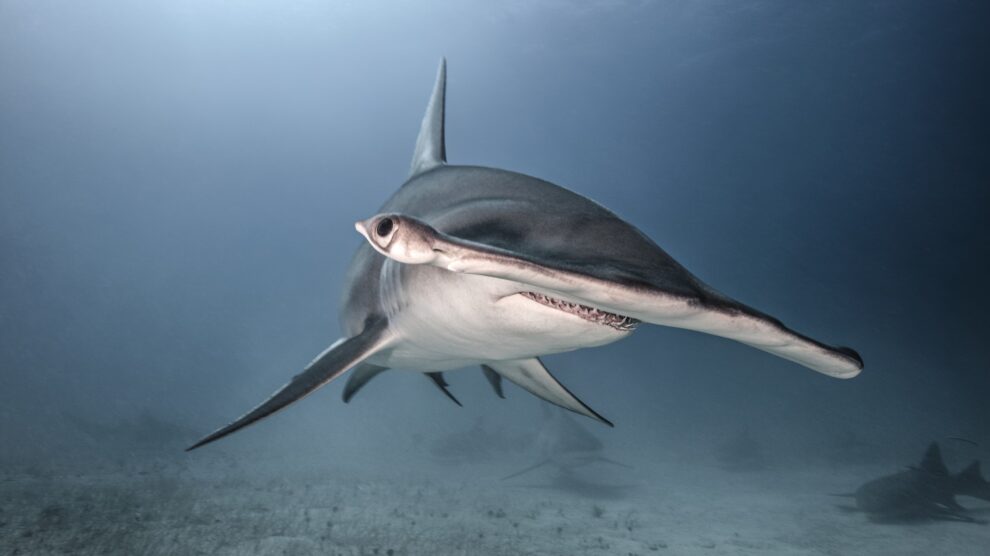Exploring the Unique Anatomy of the Hammerhead Shark: What Makes Its Head Shape So Special?
The hammerhead shark is a unique species of shark that is easily recognizable due to its distinctive head shape. This unique anatomy has been the subject of much scientific study, as researchers seek to understand what makes the hammerhead shark so special.
The hammerhead shark’s head is shaped like a hammer, with two eyes located at the end of each lobe. This unique shape is thought to provide the shark with a number of advantages. Firstly, the wide head gives the shark a greater field of vision, allowing it to detect prey more easily. Secondly, the shape of the head also increases the shark’s maneuverability, allowing it to make sharp turns and sudden changes in direction.
The hammerhead shark’s head shape also provides it with a number of other advantages. The wide head allows the shark to swim more efficiently, as it reduces drag and increases the shark’s speed. Additionally, the wide head also increases the shark’s sense of smell, allowing it to detect prey from further away.
The hammerhead shark’s unique head shape is also thought to provide it with an advantage in terms of communication. The wide head allows the shark to detect the electrical signals emitted by other sharks, allowing it to communicate with them over greater distances.
Overall, the hammerhead shark’s unique head shape provides it with a number of advantages, from increased maneuverability and speed to improved communication. This unique anatomy has been the subject of much scientific study, as researchers seek to understand what makes the hammerhead shark so special.
Uncovering the Adaptive Advantages of the Hammerhead Shark’s Hammer-Shaped Head
The hammerhead shark is a unique species of shark that is easily recognizable due to its hammer-shaped head. This unusual feature has long been a source of fascination for scientists and the general public alike. But what is the adaptive advantage of this unusual head shape?
Recent research has shed light on the adaptive advantages of the hammerhead shark’s hammer-shaped head. It has been found that the hammerhead shark’s head shape is an adaptation that allows the shark to have a wider field of vision. This is because the hammer-shaped head allows the shark to have two eyes on either side of its head, rather than just one in the front. This gives the shark a much wider field of vision, allowing it to detect prey more easily.
In addition to the wider field of vision, the hammerhead shark’s head shape also provides the shark with an advantage when it comes to hunting. The wide head shape allows the shark to have a larger mouth, which gives it the ability to take in more water and thus capture more prey.
Finally, the hammerhead shark’s head shape also provides the shark with an advantage when it comes to navigation. The wide head shape allows the shark to have a greater sense of direction, allowing it to navigate more easily in the open ocean.
Overall, the hammerhead shark’s hammer-shaped head provides the shark with a number of adaptive advantages. These advantages include a wider field of vision, a larger mouth for capturing prey, and improved navigation capabilities. These advantages have allowed the hammerhead shark to become one of the most successful species of shark in the world.
Investigating the Evolutionary History of the Hammerhead Shark: How Did Its Head Shape Come to Be?
The hammerhead shark is a species of shark that is easily recognizable due to its unique head shape. This head shape has been the subject of much scientific inquiry, as it is an example of an evolutionary adaptation that has been beneficial to the species. In order to understand how this head shape came to be, it is important to investigate the evolutionary history of the hammerhead shark.
The hammerhead shark is a member of the family Sphyrnidae, which includes nine species of sharks. These species are found in tropical and subtropical waters around the world, and they are believed to have evolved from a common ancestor approximately 20 million years ago. The hammerhead shark is thought to have evolved from the bonnethead shark, which is the only other species in the family that has a hammer-shaped head.
The hammerhead shark’s head shape is believed to be an adaptation that has allowed it to be more successful in its environment. The wide head shape gives the shark an increased field of vision, allowing it to better detect prey and predators. Additionally, the wide head shape also increases the shark’s maneuverability, allowing it to make sharp turns and sudden changes in direction.
The hammerhead shark’s head shape is also believed to be an adaptation that has allowed it to feed more efficiently. The wide head shape gives the shark an increased surface area, allowing it to capture more prey with each bite. Additionally, the wide head shape also increases the shark’s ability to sense electrical fields, which can help it locate prey that is hidden in the sand or mud.
The hammerhead shark’s head shape is an example of an evolutionary adaptation that has been beneficial to the species. By investigating the evolutionary history of the hammerhead shark, we can gain a better understanding of how this head shape came to be and why it has been so successful.

Jérôme V.
Jérôme V.Jerome est un écrivain talentueux qui excelle dans l'art de raconter des histoires captivantes. Passionné par les enjeux sociaux et les découvertes scientifiques, il apporte une touche unique à hsmaicuracao.org en explorant des sujets variés et intrigants. Avec son approche créative et éclairée, Jerome a le don de rendre l'actualité accessible à tous, suscitant la curiosité et l'engagement de nos lecteurs.

















